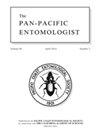CDC-CO2光捕捉器提高林奈1758种库蚊(Diptera:库蚊科)捕捉率的研究
IF 0.6
4区 农林科学
Q4 ENTOMOLOGY
引用次数: 0
摘要
研究和控制蚊子和蚊子传播的疾病。与许多监测方案一样,需要有效和高效的方案(Montgomery等人,2021),有效检测成年蚊子是常见的第一步(Peck等人,2018)。几种类型的昆虫捕捉器和诱饵已被用于捕捉蚊子,一些研究直接比较了不同的捕捉方案(例如,Kline 2006、Silver&Service 2008、Hoel等人2009、Dusfour等人2010、Roiz等人2012、Lühken等人2014、Peck等人2018、Gorsich等人2019、Mwanga等人2019、Hou等人2021、Jhaiaun等人2021、Murindahabi等人2022)。这些先前的研究发现,诱捕效果可能因蚊子个体的特征和/或条件(物种、性别、蚊子是否进食)和诱捕器(设计、位置和引诱剂)而异。两种常见的引诱剂是二氧化碳和光,这两种引诱剂都被纳入了美国疾病控制与预防中心(CDC)开发的二氧化碳捕集器中。由于CDC-CO2陷阱是常用的(Silver&Service 2008,Roiz等人2012,Sriwichai等人2015),几项研究评估了其在不同光类型和波长下的有效性。例如,Jhaiaun等人(2021)发现,一些种类的按蚊更喜欢紫外线LED(377–384 nm)和紫外线荧光灯(354–468 nm),而一些种类的库蚊更喜欢紫外线荧光灯、紫外线LED和蓝色LED(416–428 nm)。一些种类的库蚊(包括致倦库蚊Say,1823),但不是全部,比白色荧光(277–400 nm和750 nm以上)更容易被紫外线荧光(354–468 nm)吸引(Saeung等人,2021)。Costa-Neta等人(2017)还发现,与蓝色LED(470±5 nm)相比,按蚊更喜欢绿色LED(520±5 nm,两者的捕获率都高于CDC诱捕器中的标准白光。了解目标蚊子物种的偏好可以提高捕获率。本研究的目的是比较配备不同光和波长的CDC小型光阱模型512(John W.Hock Company;Gainesville,Florida,U.S.A.)的捕获率。微型CDC光阱配备工厂安装的白色白炽灯,或更换为绿色白炽灯(约520–560 nm,因为产品中不包括规格,CEC Industries有限公司;美国伊利诺伊州林肯郡)、红色LED(620–625 nm,Chanzon Technology Co.,有限公司;中国广东)、,和紫外LED灯(395–400 nm,EDGELEC,深圳市瑞达信贸易有限公司;深圳,中国)。研究地点是美国密苏里州卡尔霍恩附近的休耕农田(38.46°-93.63°),附近有草地和一个小池塘。2021年8月8日至24日的11个晚上,每个陷阱都用二氧化碳作为诱饵,包括大约0.45升的干冰,悬挂在地面上方1.75米处,在黄昏前30分钟出发,总共三个小时。在每晚的采样中,在同一场地的四个位置之间轮换陷阱,以便能够评估特定陷阱位置对捕获率的影响。每日捕获计数在数据分析之前进行平方根转换,使用Scientific Note本文章由计算机程序翻译,如有差异,请以英文原文为准。
A note on increasing capture rates of Culex pipiens Linnaeus, 1758 species-group (Diptera: Culicidae) with CDC-CO2 light traps
research, and control of mosquitoes and mosquito-borne diseases. Like many monitoring schemes, effective and efficient protocols are desired (Montgomery et al. 2021), with efficient detection of adult mosquitoes a common first step (Peck et al. 2018). Several types of insect traps and baits have been used to capture mosquitoes, and several studies have directly compared different trapping protocols (e.g. Kline 2006, Silver & Service 2008, Hoel et al. 2009, Dusfour et al. 2010, Roiz et al. 2012, Lühken et al. 2014, Peck et al. 2018, Gorsich et al. 2019, Mwanga et al. 2019, Hou et al. 2021, Jhaiaun et al. 2021, Murindahabi et al. 2022). These previous studies found that trapping effectiveness can vary based on characteristics and or condition of the individual mosquito (species, sex, whether the mosquito had fed or not) and trap (design, location, and attractant). Two common attractants are CO2 and light, both incorporated into the Centers for Disease Control and Prevention (CDC) developed CO2 traps. Because the CDC-CO2 traps are commonly used (Silver & Service 2008, Roiz et al. 2012, Sriwichai et al. 2015), several studies have assessed its effectiveness with different light types and wavelengths. For example, Jhaiaun et al. (2021) found that some species of Anopheles preferred UV LED (377–384 nm) and UV fluorescent (354–468 nm) and some species of Culex preferred UV fluorescent, UV LED, and blue LED (416–428 nm). Some species of Culex (including Culex quinquefasciatus Say, 1823), but not all, are more attracted to UV fluorescent light (354–468 nm) than white fluorescent light (277–400 nm and above 750 nm) (Saeung et al. 2021). Costa-Neta et al. (2017) also found that Anopheles mosquitoes preferred green LED (520 ± 5 nm) compared to blue LED (470 ± 5 nm), both with higher capture rates than the standard white light in a CDC trap. Understanding preferences of target mosquito species can result in increased capture rates. The goal of this study was to compare capture rates of the CDC Miniature Light Trap Model 512 (John W. Hock Company; Gainesville, Florida, U.S.A.) equipped with different lights and wavelengths. Miniature CDC light traps were equipped with the factory installed white incandescent light, or replaced with green incandescent (roughly 520–560 nm, as specifications were not included with the product, CEC Industries Ltd.; Lincolnshire, Illinois, U.S.A.), red LED (620–625 nm, Chanzon Technology Co., Ltd.; Guangdong, China), and UV LED lights (395–400 nm, EDGELEC, Shenzhen Ruidaxin Trading Co., Ltd.; Shenzhen, China). The study site was a fallow agricultural field (38.46° -93.63°) near Calhoun, Missouri, U.S.A., with grasslands and a small pond in the immediate area. Each trap was baited with CO2 by including approximately 0.45 L of dry ice, suspended 1.75 m above the ground, and set out 30 minutes before dusk for a total of three hours during 11 nights from 8–24 August 2021. In each night of sampling, traps were rotated among the four locations in the same field to be able to assess the effect of the specific trapping location on capture rates. Daily capture counts were square root transformed prior to data analysis, with Scientific Note
求助全文
通过发布文献求助,成功后即可免费获取论文全文。
去求助
来源期刊

Pan-Pacific Entomologist
生物-昆虫学
CiteScore
0.50
自引率
20.00%
发文量
47
审稿时长
>12 weeks
期刊介绍:
The Pan-Pacific Entomologist (ISSN 0031-0603) is published quarterly (January, April, July and October) by the Pacific Coast Entomological Society, in cooperation with the California Academy of Sciences. The journal serves as a refereed publication outlet and accepts manuscripts on all aspects of the biosystematics of insects and closely related arthropods, especially articles dealing with their taxonomy, biology, behavior, ecology, life history, biogeography and distribution. Membership in the Pacific Coast Entomological Society includes subscription to The Pan-Pacific Entomologist, and Society Proceedings typically appear in the October issue of each volume.
 求助内容:
求助内容: 应助结果提醒方式:
应助结果提醒方式:


